When you buy through our links, we may earn an affiliate commission.
Looking for the best audio mixer can be a real mind-bender as they come in a wide variety of types and styles. The huge range of options makes it difficult to choose.
To help you select the right audio mixer for your setup, we’ve selected the six best audio mixers. They’re easy to integrate, have plenty of IO, provide great cross-functionality, and include a USB interface.
The SSL Big SiX audio mixer came out on top based on its versatility and wide range of functionalities. It’s a great investment for musicians and producers alike. It performs exceptionally well in the studio as well as at live performances.
Quick Summary of the Best Audio Mixers
- SSL BiG SiX (Best Overall Digital Mixer)
- Allen & Heath Zed-12FX 12-Channel Audio Mixer (Best Value for Money)
- Korg SoundLink MW-1608 (Best Compact Digital Audio Mixer)
- Yamaha MG12 12-Input 4-Bus Mixer (Best Digital Audio Mixer for Small Venues)
- Mackie ProFX6v3 6-Channel Mixer (Best Audio Mixers for Solo Performers or Small Duos)
- Presonus StudioLive 32SC Mixer (Best Professional Level Mixer)
Best Audio Mixers
1. Best Overall Digital Mixer – SSL BiG SiX
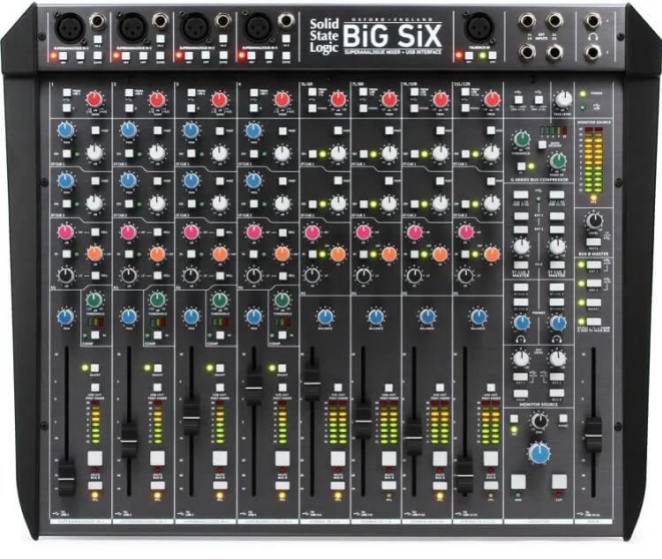
SPECS
- Type: Analog Mixer with USB Interface
- Channels: 18 Inputs (includes summing and inserts), 8 Fader Channels
- Inputs - Mic Preamps: 4 x XLR
- EQ Bands: 3-band EQ, High/Low Bell Curve, Mid Frequency Shift
The popular SiX audio mixers from SSL are now available in an upgraded, larger version called the SSL BiG SiX.
The audio mixer includes SuperAnalogue mic preamps which offer exceptional sound quality and transparency. They capture audio signals accurately with minimal coloration. This significantly enhances the overall audio quality.
The built-in SSL (Solid State Logic) Channel Dynamics processors include features like compression, gating, and expansion, thus giving you precise control over the audio dynamics. This allows you to achieve a beautifully polished sound.
To help shape the tonal balance on individual audio channels, the Big SiX audio mixer includes an excellent 3-band EQ (treble, midrange, bass).
You have complete control over different frequency ranges. Giving you the ability to enhance or attenuate specific frequencies as you need.
While the channel count is important, only you can decide whether the 16 channels will meet your demands.
For home studio use as well as small to medium-sized venues, we think it provides adequate coverage. Provided, of course, that you don’t have an extremely complex setup.
It’s always nice to have a fully balanced insert point, as it allows you to connect external signal processors. This includes compressors and equalizer audio interfaces with individual channels.
The Big SiX audio mixer gives you complete control by allowing you to incorporate external effects into your audio chain in a balanced fashion.
2. Best Value for Money – Allen & Heath Zed-12FX 12-Channel Audio Mixer

SPECS
- Type: Analog
- Channels: 12
- Inputs - Mic Preamps: 6 x XLR
- EQ Bands: 3-band, Sweepable Mid (CH 1-6), 2-band (CH 7-12 Stereo)
Allen & Heath digital mixing desks are well-known for their performance and value. The Zed-12FX 12-Channel packs an awesome amount of advanced technology into a compact frame.
This 12-channel digital audio mixer with 6 microphone/line inputs accommodates multiple audio sources simultaneously.
This allows you to mix and control a variety of different audio sources. This includes vocals, instruments, and playback devices in either a live or studio setting.
The four auxiliary sends allow you to create separate monitor mixes or send signals to external effects processors. This audio interface facilitates mixes for on-stage performers or adding audio signals to external effects units.
If you’re looking for amplification for microphones, then the +69dB gain preamps will ensure optimal signal levels with low noise. It allows you to capture noise-free sound from low-output microphones accurately.
For exquisite tonal shaping, the 3-Band EQ on main channels and 2-Band EQ on stereo channels help you create the exact sound you’re after.
So, if you’re worried about getting the frequency balance just right, the Zed-12FX helps attenuate or boost specific frequencies. It enhances the clarity and balance of the audio mix.
The USB audio interface facilitates connectivity with a computer or recording device. This allows you to record and playback audio.
These specifications offer awesome flexibility, control, and high-quality audio processing capabilities. It allows you to create professional sound mixes in both live events and your studio.
3. Best Compact Digital Audio Mixer – Korg SoundLink MW-1608
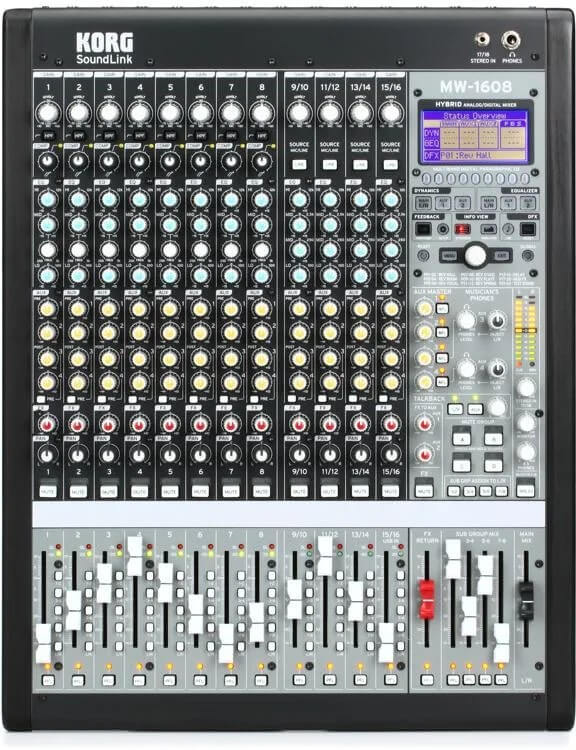
SPECS
- Type: Analog Mixer with USB Interface
- Channels: 16
- Inputs - Mic Preamps: 12 x XLR, 8 x 1/4" TRS, 8 x 1/4" TRS (4 x stereo)
- EQ Bands: 3-band EQ with Sweepable Mid (mono channel), 4-band EQ (stereo channel), Digital EQ
With eight stereo channels, you can connect to a wider range of audio sources. These include stereo instruments, playback devices, or line-level audio inputs. It is ideal for handling keyboards, synthesizers, stereo effects units, or stereo playback devices.
The Korg is one of the best audio mixers on the market, allowing you to manipulate sound creatively and adding special enhancements to your audio mix. You’ll be amazed at your ability to add depth and ambiance to your music with such a compact audio mixer.
Peter Watts-Designed High-Voltage Preamps are known for their superior audio quality. You can be sure that you’ll capture perfect audio with transparency and low noise for accurate, natural sound reproduction.
With the inclusion of 32-bit velvet sound AD/DA converters, you’ll preserve the integrity and fidelity of the audio signals.
These specifications offer you advanced audio processing capabilities and top-notch preamplification. It also includes high-quality signal conversion in a compact package. This makes it ideal for live sound events, producing professional-level results.
4. Best Digital Audio Mixer for Small Venues – Yamaha MG12 12-Input 4-Bus Mixer
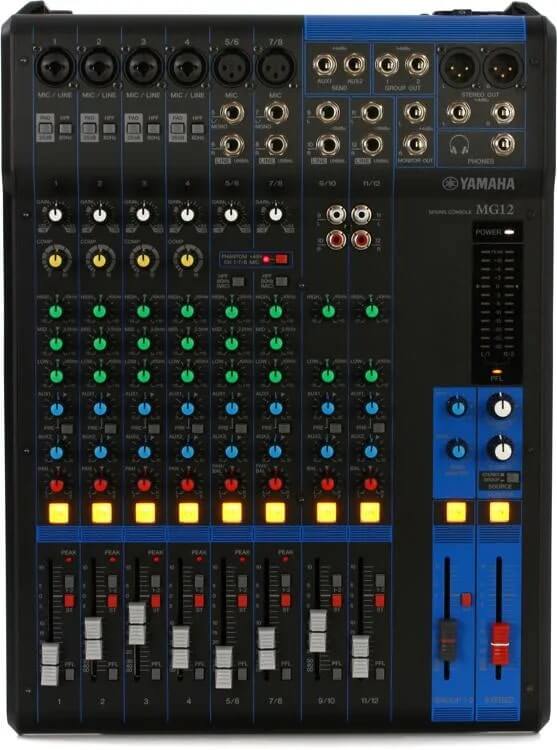
SPECS
- Type: Analog
- Channels: 12
- Inputs - Mic Preamps: 4 x XLR/TRS Combo, 2 x XLR, 4 x TRS
- EQ Bands: 3-band
This audio mixer is ideal for live events in smaller venues. Its 12-channel analog audio mixer with 6 microphone preamps and 4 dedicated stereo line channels fit the bill perfectly.
The audio interface provides a flexible and versatile option for handling a variety of audio sources with phantom power options as well.
With 2 aux sends, an EQ, and a 1-knob compressor, you have everything you need to shape the sound equalization.
You can apply dynamic control while adding digital effects. In small venues, creative expression is extremely difficult. But the Yamaha MG12 is more than up to the task.
The D-PRE preamps deliver transparent, natural-sounding audio reproduction. The very accurate bass and smooth, high-frequency response are impressive. You’ll also be amazed at the clear, accurate sound reproduction that you can achieve with this setup.
The switchable phantom power and pad switch offer additional flexibility. This is especially true if you use condenser microphones or attenuating high-level signals. Phantom power allows you to adjust the input level for both sensitive microphones and line-level signals.
The 48-volt DC phantom power is transmitted through the same balanced audio cable that carries your audio signal. The result is great compatibility and optimal signal levels.
5. Best Audio Mixers for Solo Performers or Small Duos – Mackie ProFX6v3 6-Channel Mixer
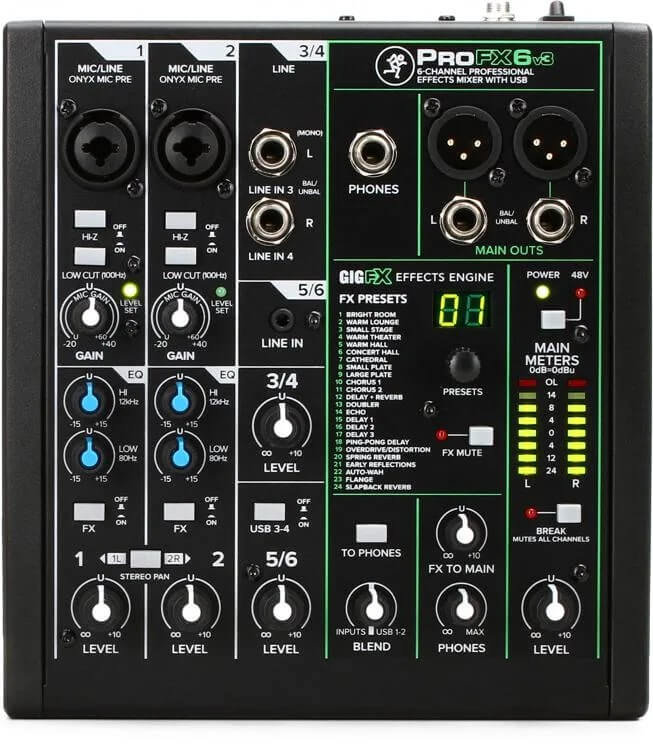
SPECS
- Type: Analog Mixer with USB Interface
- Channels: 6 (2 x mono, 2 x stereo)
- Inputs - Mic Preamps: 2 x XLR-1/4" combo (mic/line/Hi-Z)
- EQ Bands: 2-band EQ, 100Hz Low-cut Filter
With 6 channels, you can connect and mix multiple audio sources simultaneously. This gives you flexibility when handling multiple audio inputs. Options include microphones, instruments, or line-level signals.
You can connect directly to your computer or recording device with the USB audio interface. It gives you great multitrack recording and post-production capabilities.
The XLR/1/4" TRS combo jacks give you the ability to connect microphones, instruments, or line-level devices directly to the mixer using XLR or 1/4" TRS cables.
You can then accommodate a wide range of audio equipment, and it ensures compatibility with a variety of professional audio gear.
The class-A D-PRE mic preamps allow you to capture clean, accurate audio. They help preserve the natural characteristics of microphone recordings.
It's done by providing high-quality, transparent, and low-noise amplification for microphone signals. This results in pristine sound quality without noise or distortion.
6. Best Professional Level Mixer – Presonus StudioLive 32SC Mixer
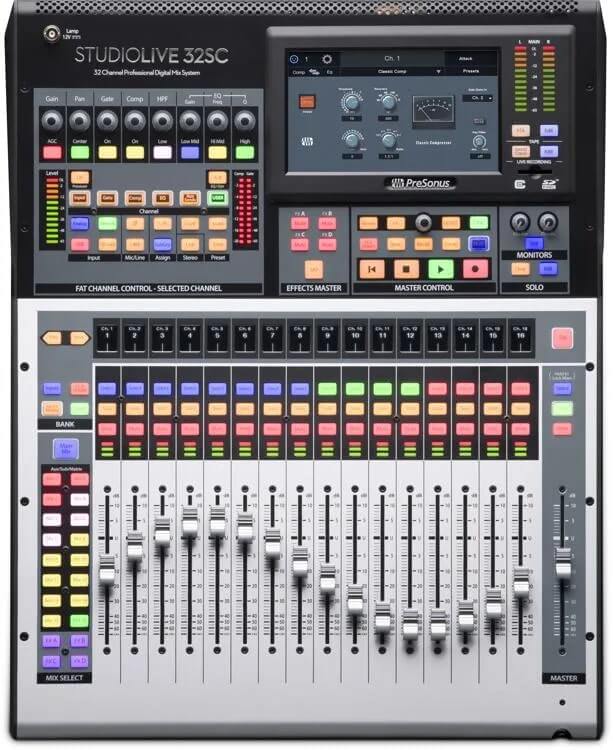
SPECS
- Type: Digital Mixer
- Channels: 32 input channels, 40 mix channels
- Inputs - Mic Preamps: 8 x XLR (mic), 8 x XLR-1/4" combo (mic/line)
- EQ Bands: Various types
The PreSonus StudioLive 32SC is a flexible live sound mixer designed for professional use. You’ll have the ability to engage multiple inputs and outputs while enjoying a variety of expandability options.
You can enjoy extensive audio mixing capabilities and high-resolution processing. This is possible due to the availability of 32 channels and a 32-bit floating-point processor.
The 32SC mixer gives you the ability to handle large-scale audio productions. These include live performances or complex recording sessions.
The motorized faders make it a lot easier to transition seamlessly between different sections. This is especially true when dealing with a large project. They offer you automated control as well as the recall of channel settings for quick adjustments and scene recalls.
You can record channels separately, preserving your flexibility during post-production. This allows you to address specific audio elements during the mixing and editing stages.
The combination of XLR jacks and 1/4" TRS combo jacks gives you versatile input options for a variety of audio sources.
This includes microphones, instruments, and line-level sources. Using XLR cables or 1/4" TRS cables allows you to accommodate different audio equipment and simplifies connectivity.
Best Audio Mixers Buyer's Guide
When shopping for audio mixers, there are a few important considerations to bear in mind. To help you with your decision, this buyer's guide covers what to look for when choosing the best audio mixer for your needs.
We’ll cover analog audio mixers, digital mixers, and powered audio mixers. Specifically, we’ll look at key considerations like power and amplification, channel count and features, portability, and durability, as well as connectivity and expansion options.
Analog Audio Mixers
Analog audio mixers are considered old-fashioned by some, but they provide a depth and quality that is lacking in digital audio mixers.
Your first concern should be the channel count and how many input channels you require for your setup.
Keep in mind that you need to include the number of microphones, various instruments, as well as other audio sources that you'll need to connect simultaneously.
Ensure that the analog mixers you choose have enough channels to handle your anticipated needs.
Next up is signal quality. Look for mixers with high-quality preamps and audio circuitry to ensure clean and transparent signal processing. Think SSL (Solid State Logic) or Yamaha's D-PRE preamps. You’ll also want a mixer with a frequency response; aim for a range of 20 Hz to 20 kHz.
While a higher signal-to-noise ratio is preferable, typical higher-quality setups are around 90 dB or higher for a cleaner and more accurate audio signal with less unwanted noise.
Depending on your circumstances, you may need to go higher than 100 dBs, especially if you are recording in a studio or broadcasting.
Assess the available input and output options, such as what XLR inputs, TRS, and RCA connector options are offered. Make sure that the mixer you choose has the right types and sufficient quantities of inputs and outputs to connect all your audio sources and other equipment.
Digital Audio Mixers
Digital audio mixers often offer the ability to expand the channel count. This scalability is desirable, especially if you are on a budget. By using additional input/output cards or stage boxes, you can prolong the useful life of your equipment.
The processing capabilities of your digital mixer, especially advanced DSP (Digital Signal Processing) features, onboard effects, dynamics processors, and EQ options, are features to look for.
Ensure that the mixer you choose can handle your required level of signal processing and provide all the desired effects.
Have a look at the user interface, paying close attention to the touchscreen, menu navigation, and software controls. You’re looking for a workflow that is intuitive and efficient, allowing you to access and adjust parameters easily during live performances or studio sessions.
Finally, you want to consider your digital mixer's connectivity options carefully. Look closely at the specifications related to digital audio interfaces (USB, Thunderbolt), network capabilities (Ethernet, Dante), and MIDI integration.
You want to focus on ensuring the mixer can seamlessly integrate with your existing equipment and software setup.
Powered Audio Mixers
When selecting a powered audio mixer, you’ll want to determine the power requirements for your headphone output, speakers, and PA system. To do this, you need to check the sensitivity rating of your speakers. Higher sensitivity speakers require less power to achieve your desired volume level.
Next, consider the size of your venue as well as the acoustics. Larger venues or spaces with poor acoustics may require more power to fill the room effectively and ensure an even sound distribution.
The size of your audience, as well as the type of venue and genre of music, will also affect your power requirements.
The speaker layout will affect the power you require, with mono, stereo, and surround sound setups needing increasing power. You also want to make sure that you don’t overload your system.
So whatever power rating you work out, add a little extra as a safety margin to prevent damage to your equipment.
As with other audio mixers, you want to make sure that you have a sufficient number of input channels as well as the availability of built-in effects, EQ, and other more advanced processing options.
As you gain experience, you’ll need equipment to keep up with your skills, so ensure that the powered mixer you choose offers the required features to meet your growing audio mixing needs.
If you are going to record audio tracks and mix at live events, then portability and durability become key issues. Not only should the weight and size be manageable, but pay attention to the build quality of your powered mixer.
Consider whether it is designed for easy transportation and if it can withstand the rigors of live performances and portable setups.
Line Audio Mixers
Line audio mixers are primarily designed for handling line-level signals. These audio signals are preamplified and reach your mixer at a higher voltage level than microphone-level signals.
Unlike mixers that are specifically designed for microphones, line audio mixers are optimized for handling audio sources from musical instruments, media players, and synthesizers.
They are designed to provide a separate audio interface, controls, and routing options to manage and mix multiple line-level sources.
When selecting a line audio mixer, you’ll notice that they often have more line-level inputs compared to microphone inputs. You need a combination of 1/4-inch TRS (Tip-Ring-Sleeve) jacks and RCA connectors to accommodate a variety of audio sources.
The advantage of using a line audio mixer is that it can handle line-level signals without the need for additional pre-amplification. This allows you to connect the line-level devices and the mixer directly. This eliminates external preamps or DI (Direct Injection) boxes.
With built-in equalization, level control, panning, and routing options, line audio mixers allow you to adjust the frequency response, balance levels, pan signals between stereo channels, and route signals to different outputs or auxiliary sends.
The ability to connect line-level sources without the need for preamplification or DI boxes reduces complexity and your setup time. This is particularly useful in live sound scenarios or quick studio setups where efficiency is crucial.
The flexibility offered by line mixers allows for creative signal routing and customized mixing configurations.
You’ll be able to apply EQ adjustments to fine-tune the tonal balance, as well as control levels for each source. This gives you precise control over the audio mix and helps to achieve the desired sonic characteristics with a separate audio interface.
If you record in studios, at live performances, in DJ setups, and in broadcast facilities, then a line audio mixer is well worth considering. Alternatively, you can choose an audio mixer that has many of these features built-in.
Frequently Asked Questions (FAQs)
What is the difference between an analog mixer and a digital mixer?
An analog mixer processes audio signals using analog circuitry. It takes the electrical voltages generated by microphones, instruments, and other audio sources and manipulates them using physical knobs, sliders, and switches.
Digital mixers process audio signals using digital circuitry and convert analog signals into digital form for processing.
What level should a mixer be?
To set your levels, slowly raise the volume on your speaker/audio interface/monitor controller until you reach somewhere between 70dB (for a small room) and 85dB (for a large room). Do not calibrate at a level higher than 85 dB.
What should I turn on first, the mixer or amplifier?
Connect mics, mixer, outboard effects, and output cable connections with all devices off. Then turn on your outboard effects units first. Next, turn on your mixer, followed by any speaker or amplifier DSP units. Finally, turn on your amplifiers or powered speakers.
How do I make sure my mix sounds good on all speakers?
You should set up your speakers so that they form an equilateral triangle, with you as one point of the triangle. Each speaker is then equidistant from you and each other.
Do I need an equalizer if I have a mixer?
Equalizers or EQs boost, decrease, and cut frequencies, while mixers are used to route audio signals to various places. An EQ is a vital component, whereas a mixer is only required if you are mixing two audio signals together.
Conclusion
While a digital audio workstation provides a convenient method of recording, editing, and producing digital audio, the best audio mixers provide a unique character to music production.
Our number 1 choice, the SSL BiG SiX, provides a tactile experience that is hard to recreate. The creative workflow, including riding faders & EQs, is almost impossible to mimic.
With some mixers providing the ability to save to a hard drive, the cost versus connectivity swings in favor of a quality audio mixer.
With the best home studio audio mixers - both analog, digital, and hybrids - offering you the functionality to record multiple sources, isn’t it time you take the plunge and buy an audio mixer today?
